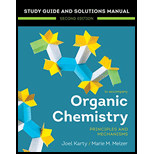
EBK ORGANIC CHEMISTRY: PRINCIPLES AND M
2nd Edition
ISBN: 9780393543971
Author: KARTY
Publisher: VST
expand_more
expand_more
format_list_bulleted
Concept explainers
Question
Chapter 8, Problem 8.18YT
Interpretation Introduction
Interpretation:
All the resonance structures of each of the carbocation ion in Equation 8-41 are to be drawn.
Concept introduction:
A carbocation has one carbon atom with a positive charge and an incomplete octet. If this is located one bond away from an electron-rich atom or region, an alternate Lewis structure can be drawn. The alternate structure is called a resonance hybrid. A lone pair from the electron-rich atom of a
Expert Solution & Answer
Want to see the full answer?
Check out a sample textbook solution
Students have asked these similar questions
Draw the major product of the Claisen condensation reaction between two molecules of this ester. Ignore
inorganic byproducts.
Incorrect, 5 attempts remaining
1. NaOCH3/CH3OH
2. Acidic workup
Select to Draw
O
Incorrect, 5 attempts remaining
The total number of carbons in the parent chain is incorrect. Review the reaction conditions including starting materials and/or
intermediate structures and recount the number of carbon atoms in the parent chain of your structure.
OK
Using a cell of known pathlength b = 1.25115 x 10-3 cm, a water absorption spectrum was measured. The band at 1645 cm-1, assigned to the O-H bending, showed an absorbance, A, of 1.40.
a) Assuming that water density is 1.00 g/mL, calculate the water molar concentration c (hint: M= mole/L)
b) Calculate the molar absorptivity, a, of the 1645 cm-1 band
c) The transmitted light, I, can be written as I= Ioexp(-xb), where x is the absorption coefficient (sometimes designated as alpha), Io is the input light, and b is the cell pathlength. Prove that x= (ln10)*x*c
d) Calculate x for the 1645 cm-1 band
Convert 1.38 eV into wavelength (nm) and wavenumber (cm-1) (c = 2.998 x 108 m/s; h = 6.626 x 10-34 J*s).
Chapter 8 Solutions
EBK ORGANIC CHEMISTRY: PRINCIPLES AND M
Ch. 8 - Prob. 8.1PCh. 8 - Prob. 8.2PCh. 8 - Prob. 8.3PCh. 8 - Prob. 8.4PCh. 8 - Prob. 8.5PCh. 8 - Prob. 8.6PCh. 8 - Prob. 8.7PCh. 8 - Prob. 8.8PCh. 8 - Prob. 8.9PCh. 8 - Prob. 8.10P
Ch. 8 - Prob. 8.11PCh. 8 - Prob. 8.12PCh. 8 - Prob. 8.13PCh. 8 - Prob. 8.14PCh. 8 - Prob. 8.15PCh. 8 - Prob. 8.16PCh. 8 - Prob. 8.17PCh. 8 - Prob. 8.18PCh. 8 - Prob. 8.19PCh. 8 - Prob. 8.20PCh. 8 - Prob. 8.21PCh. 8 - Prob. 8.22PCh. 8 - Prob. 8.23PCh. 8 - Prob. 8.24PCh. 8 - Prob. 8.25PCh. 8 - Prob. 8.26PCh. 8 - Prob. 8.27PCh. 8 - Prob. 8.28PCh. 8 - Prob. 8.29PCh. 8 - Prob. 8.30PCh. 8 - Prob. 8.31PCh. 8 - Prob. 8.32PCh. 8 - Prob. 8.33PCh. 8 - Prob. 8.34PCh. 8 - Prob. 8.35PCh. 8 - Prob. 8.36PCh. 8 - Prob. 8.37PCh. 8 - Prob. 8.38PCh. 8 - Prob. 8.39PCh. 8 - Prob. 8.40PCh. 8 - Prob. 8.41PCh. 8 - Prob. 8.42PCh. 8 - Prob. 8.43PCh. 8 - Prob. 8.44PCh. 8 - Prob. 8.45PCh. 8 - Prob. 8.46PCh. 8 - Prob. 8.47PCh. 8 - Prob. 8.48PCh. 8 - Prob. 8.49PCh. 8 - Prob. 8.50PCh. 8 - Prob. 8.51PCh. 8 - Prob. 8.52PCh. 8 - Prob. 8.53PCh. 8 - Prob. 8.54PCh. 8 - Prob. 8.55PCh. 8 - Prob. 8.56PCh. 8 - Prob. 8.57PCh. 8 - Prob. 8.58PCh. 8 - Prob. 8.59PCh. 8 - Prob. 8.60PCh. 8 - Prob. 8.61PCh. 8 - Prob. 8.62PCh. 8 - Prob. 8.63PCh. 8 - Prob. 8.64PCh. 8 - Prob. 8.65PCh. 8 - Prob. 8.66PCh. 8 - Prob. 8.67PCh. 8 - Prob. 8.68PCh. 8 - Prob. 8.69PCh. 8 - Prob. 8.70PCh. 8 - Prob. 8.71PCh. 8 - Prob. 8.72PCh. 8 - Prob. 8.73PCh. 8 - Prob. 8.74PCh. 8 - Prob. 8.75PCh. 8 - Prob. 8.76PCh. 8 - Prob. 8.1YTCh. 8 - Prob. 8.2YTCh. 8 - Prob. 8.3YTCh. 8 - Prob. 8.4YTCh. 8 - Prob. 8.5YTCh. 8 - Prob. 8.6YTCh. 8 - Prob. 8.7YTCh. 8 - Prob. 8.8YTCh. 8 - Prob. 8.9YTCh. 8 - Prob. 8.10YTCh. 8 - Prob. 8.11YTCh. 8 - Prob. 8.12YTCh. 8 - Prob. 8.13YTCh. 8 - Prob. 8.14YTCh. 8 - Prob. 8.15YTCh. 8 - Prob. 8.16YTCh. 8 - Prob. 8.17YTCh. 8 - Prob. 8.18YTCh. 8 - Prob. 8.19YT
Knowledge Booster
Learn more about
Need a deep-dive on the concept behind this application? Look no further. Learn more about this topic, chemistry and related others by exploring similar questions and additional content below.Similar questions
- Can you help me understand the CBC method on metal bridging by looking at this problem?arrow_forwardA partir de Aluminio y Co(NO3)2ꞏ6H2O, indicar las reacciones a realizar para obtener Azul de Thenard (Al2CoO4).arrow_forwardTo obtain Thenard Blue (Al2CoO4), the following reaction is correct (performed in an oven):Al(OH)3 + Co(OH)2 → Al2CoO4 + 4 H2Oarrow_forward
arrow_back_ios
SEE MORE QUESTIONS
arrow_forward_ios
Recommended textbooks for you
 Organic Chemistry: A Guided InquiryChemistryISBN:9780618974122Author:Andrei StraumanisPublisher:Cengage Learning
Organic Chemistry: A Guided InquiryChemistryISBN:9780618974122Author:Andrei StraumanisPublisher:Cengage Learning

Organic Chemistry: A Guided Inquiry
Chemistry
ISBN:9780618974122
Author:Andrei Straumanis
Publisher:Cengage Learning